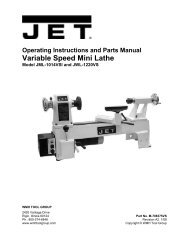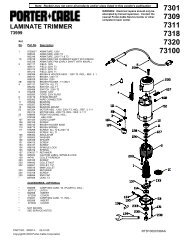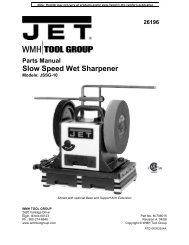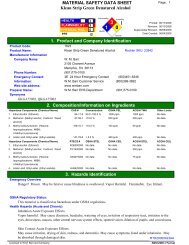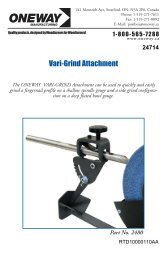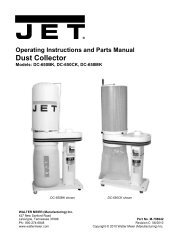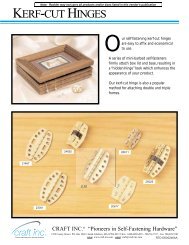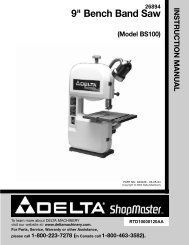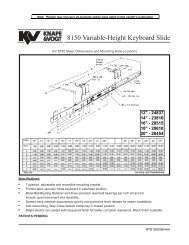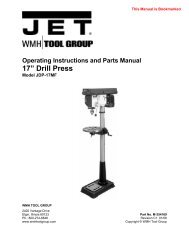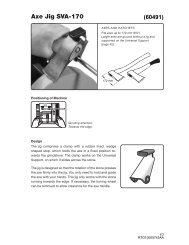Klean-Strip Japan Drier MATERIAL SAFETY DATA ... - Rockler.com
Klean-Strip Japan Drier MATERIAL SAFETY DATA ... - Rockler.com
Klean-Strip Japan Drier MATERIAL SAFETY DATA ... - Rockler.com
Create successful ePaper yourself
Turn your PDF publications into a flip-book with our unique Google optimized e-Paper software.
<strong>MATERIAL</strong> <strong>SAFETY</strong> <strong>DATA</strong> SHEET<strong>Klean</strong>-<strong>Strip</strong> <strong>Japan</strong> <strong>Drier</strong>Page:1HEALTH 2FLAMMABILITY 2PHYSICAL HAZ.PPE0GFlammabilityHealth12Instability0Special1. Product and Company IdentificationProduct Code:PJD40Product Name:<strong>Klean</strong>-<strong>Strip</strong> <strong>Japan</strong> <strong>Drier</strong>Reference #: 1000.2BManufacturer InformationCompany Name:W. M. Barr2105 Channel AvenueMemphis, TN 38113Phone Number: (901)775-0100Emergency Contact: 3E 24 Hour Emergency Contact (800)451-8346Information: W.M. Barr Customer Service (800)398-3892Web site address:www.wmbarr.<strong>com</strong>Preparer Name: W.M. Barr EHS Department (901)775-01002. Composition/Information on IngredientsPrinted: 12/12/2005Revision: 08/30/2005Hazardous Components (Chemical Name)CAS # Percentage OSHA TWA ACGIH TWA Other Limits1.2.Stoddard solventZirconium 2-Ethylhexanoate8052-41-322464-99-980.0 -85.0 %5.0 -10.0 %500 ppmNo data.100 ppmNo data.No data.No data.3. Hexanoic acid, 2-ethyl-, cobalt(2+) salt 136-52-7 1.0 -5.0 % No data. No data. No data.4. Cobalt naphthenate 61789-51-3 1.0 -5.0 % No data. No data. No data.5. Hexanoic acid, 2-ethyl-, manganese salt 15956-58-8 1.0 -5.0 % No data. No data. No data.6. Naphthenic acids, manganese salts 1336-93-2 1.0 -5.0 % No data. No data. No data.Hazardous Components (Chemical Name) RTECS # OSHA STEL OSHA CEIL ACGIH STEL ACGIH CEIL1.2.Stoddard solventZirconium 2-EthylhexanoateWJ8925000NA500 ppm/(10min)No data.300 ppmNo data.150 ppmNo data.No data.No data.3. Hexanoic acid, 2-ethyl-, cobalt(2+) salt NA No data. No data. No data. No data.4. Cobalt naphthenate QK8925000 No data. No data. No data. No data.5. Hexanoic acid, 2-ethyl-, manganese salt NA No data. No data. No data. No data.6. Naphthenic acids, manganese salts QK8985000 No data. No data. No data. No data.3. Hazards Identification<strong>Rockler</strong> SKU: 55749Emergency OverviewCaution! Combustible. Keep away from heat, sparks, flame and all other sources of ignition.OSHA Regulatory Status:This material is classified as hazardous under OSHA regulations.Health Hazards (Acute and Chronic)Inhalation Acute Exposure Effects:May cause dizziness; headache; irritation of respiratory tract; loss of coordination; drowsiness; fatigue; narcosis;weakness; difficulty breathing; blurred vision; tightness and pain in chest; coughing; nausea; pneumoconiosis;muscle twitches; eye irritation; vomiting; light headedness; and depression and damage to central nervous system.Severe overexposure may cause convulsions, unconsciousness, and death.Skin Contact Acute Exposure Effects:May cause irritation, redness, burning, drying, and cracking of the skin.Eye Contact Acute Exposure Effects:May cause redness, stinging, tearing, and irritation.Licensed to W.M. Barr and CompanyRTD20000143AAANSI Z400.1 Format
<strong>MATERIAL</strong> <strong>SAFETY</strong> <strong>DATA</strong> SHEET<strong>Klean</strong>-<strong>Strip</strong> <strong>Japan</strong> <strong>Drier</strong>Page: 2Printed: 12/12/2005Revision: 08/30/2005Ingestion Acute Exposure Effects:Harmful or fatal if swallowed. May cause headache; dizziness; nausea; vomiting; drowsiness; fatigue; loss ofcoordination; depression; gastrointestinal irritation; weakness; muscle twitches; diarrhea; depression of the centralnervous system; convulsions; unconsciousness; and death. Liquid aspirated into lungs can cause damage orchemical pneumonitis, which can be fatal.Chronic Exposure Effects:Reports have associated repeated and prolonged overexposure to solvents with neurological and otherphysiological damage. May cause skin irritation; drying, burning, redness, and cracking of skin; anemia; bonemarrow damage; liver damage; and jaundice.Signs and Symptoms Of ExposurePrimary Routes of Exposure:Inhalation; ingestion; and dermal.Medical Conditions Generally Aggravated By ExposureDiseases of the skin, liver, kidneys, central nervous system, cardiovascular system, and respiratory system,psychiatric disorders, and alcoholism.OSHA Hazard Classes:HEALTH HAZARDS : N/EPHYSICAL HAZARDS : N/ETARGET ORGANS & EFFECTS: N/E4. First Aid MeasuresEmergency and First Aid ProceduresInhalation:If user experiences breathing difficulty, move to air free of vapors. Administer oxygen or artificial respirationuntil medical assistance can be rendered.Skin Contact:Irritation may result. Immediately wash with soap and water.Eye Contact:Immediately flush with water, remove any contact lenses, continue flushing with water for at least 15 minutes,then get medical attention.Ingestion:Do not induce vomiting. Call you local poison control center, hospital emergency room, or physicianimmediately for instructions.Note to PhysicianCall your local poison control center for further information.5. Fire Fighting MeasuresFlammability Classification: OSHA Class IIFlash Pt:114.00 F Method Used: SCCExplosive Limits: LEL: 0.8 UEL: No data.Autoignition Pt:No data.Special Fire Fighting ProceduresSelf-contained respiratory protection should be provided for fire fighters fighting fires in buildings or confinedareas. Storage containers exposed to fire should be kept cool with water spay to prevent pressure build-up. Stayaway from heads of containers that have been exposed to intense heat or flame.Licensed to W.M. Barr and CompanyANSI Z400.1 Format
<strong>MATERIAL</strong> <strong>SAFETY</strong> <strong>DATA</strong> SHEET<strong>Klean</strong>-<strong>Strip</strong> <strong>Japan</strong> <strong>Drier</strong>Page: 3Printed: 12/12/2005Revision: 08/30/2005Unusual Fire and Explosion HazardsNo data available.Extinguishing MediaUse carbon dioxide, dry powder, or foam.Unsuitable Extinguishing MediaNo data available.6. Accidental Release MeasuresSteps To Be Taken In Case Material Is Released Or SpilledCleanup:Keep unnecessary people away; isolate hazard area and deny entry. Stay upwind, out of low areas, and ventilateclosed spaces before entering. Shut off ignition sources; keep flares, smoking or flames out of hazard area.Small Spills:Take up liquid with sand, earth or other non<strong>com</strong>bustible absorbent material and place in a plastic container whereapplicable.Large Spills:Dike far ahead of spill for later disposal.7. Handling and StoragePrecautions To Be Taken in HandlingRead carefully all cautions and directions on product label before use. Since empty container retains residue,follow all label warnings even after container is empty. Dispose of empty container according to all regulations.Do not reuse this container.Precautions To Be Taken in StoringKeep container tightly closed when not in use. Store in a cool, dry place. Do not store near flames or at elevatedtemperatures.8. Exposure Controls/Personal ProtectionRespiratory Equipment (Specify Type)For OSHA controlled work place and other regular users --Use only with adequate ventilation under engineeredair control systems designed to prevent exceeding appropriate TLV. For occasional use, where engineered aircontrol is not feasible, use properly maintained and properly fitted NIOSH approved respirator for organic solventvapors. A dust mask does not provided protection against vapors.Eye ProtectionSafety glasses, chemical goggles or face shields are re<strong>com</strong>mended to safeguard against potential eye contact,irritation, or injury. Contact lenses should not be worn while working with chemicals.Protective GlovesWear impermeable gloves. Gloves contaminated with product should be discarded. Promptly remove clothingthat be<strong>com</strong>es soiled with product.Other Protective ClothingVarious application methods can dictate the use of additional protective safety equipment, such as impermeableaprons, etc., to minimize exposure. A source of clean water should be available in the work area for flushingeyes and skin. Do not eat, drink, or smoke in the work area. Wash hands thoroughly after use. Before reuse,thoroughly clean any clothing or protective equipment that has been contaminated by prior use. Discard anyclothing or other protective equipment that cannot be decontaminated, such as gloves or shoes.VentilationUse only with adequate ventilation to prevent buildup of vapors. Do not use in areas where vapors canaccumulate and concentrate such as basements, bathrooms, or small enclosed areas. Whenever possible, useoutdoors in an open area. If using indoors, open all windows and doors and maintain a cross ventilation ofLicensed to W.M. Barr and CompanyANSI Z400.1 Format
<strong>MATERIAL</strong> <strong>SAFETY</strong> <strong>DATA</strong> SHEET<strong>Klean</strong>-<strong>Strip</strong> <strong>Japan</strong> <strong>Drier</strong>Page: 4Printed: 12/12/2005Revision: 08/30/2005moving fresh air across the work area. If strong odor is noticed or you experience slight dizziness, headache,nausea or eye-watering -- Stop -- ventilation is inadequate. Leave area immediately. If the work area is not wellventilated, then do not use this product. A dust mask does not provide protection against vapors.9. Physical and Chemical PropertiesPhysical States: [ ] Gas [ X ] Liquid [ ] SolidMelting Point:No data.Boiling Point:> 300.00 FAutoignition Pt:No data.Flash Pt:114.00 F Method: SCCExplosive Limits: LEL: 0.8 UEL: No data.Specfic Gravity: 0.000000Bulk Density:6.679 LB/GAVapor Presure:No data.Vapor Density:No data.Evaporation Rate:No data.Solubility in Water:No data.Percent Volatile:91.21 % by weight.VOC / Volume:730.0000 G/LCorrosion Rate:No data.pH:No data.Appearance and OdorNo data available.10. Stability and ReactivityStability: Unstable [ ] Stable [ X ]Conditions To Avoid - InstabilityNo data available.In<strong>com</strong>patibility - Materials To AvoidIn<strong>com</strong>patible with strong oxidizing agents; reducing agents; halogens; and sulfur.Hazardous De<strong>com</strong>position Or ByproductsDe<strong>com</strong>position may produce carbon monoxide, carbon dioxide and toxic fumes.Hazardous Polymerization: Will occur [ ] Will not occur [ X ]Conditions To Avoid - Hazardous PolymerizationNo data available.11. Toxicological InformationToxicological InformationNo data available.Carcinogenicity/Other InformationNo data available.Carcinogenicity: NTP? No IARC Monographs? No OSHA Regulated? NoEcological InformationNo data available.12. Ecological InformationLicensed to W.M. Barr and CompanyANSI Z400.1 Format
<strong>MATERIAL</strong> <strong>SAFETY</strong> <strong>DATA</strong> SHEET<strong>Klean</strong>-<strong>Strip</strong> <strong>Japan</strong> <strong>Drier</strong>Page: 5Printed: 12/12/2005Revision: 08/30/200513. Disposal ConsiderationsWaste Disposal MethodDispose in accordance with local, state, and federal regulations.LAND TRANSPORT (US DOT)DOT Proper Shipping NameNo data available.14. Transport InformationUS EPA SARA Title III15. Regulatory InformationHazardous Components (Chemical Name)CAS # Sec.302 (EHS) Sec.304 RQ Sec.313 (TRI) Sec.1101.2.Stoddard solventZirconium 2-Ethylhexanoate8052-41-322464-99-9NoNoNoNoNoNoNoNo3. Hexanoic acid, 2-ethyl-, cobalt(2+) salt 136-52-7 No No Yes-Cat. N096 Yes4. Cobalt naphthenate 61789-51-3 No No Yes-Cat. N096 Yes5. Hexanoic acid, 2-ethyl-, manganese salt 15956-58-8 No No Yes-Cat. N450 No6. Naphthenic acids, manganese salts 1336-93-2 No No Yes-Cat. N450 NoUS EPA CAA, CWA, TSCAHazardous Components (Chemical Name)CAS # EPA CAA EPA CWA NPDES EPA TSCA CA PROP 651.2.Stoddard solventZirconium 2-Ethylhexanoate8052-41-322464-99-9NoNoNoNoNoNoNoNo3. Hexanoic acid, 2-ethyl-, cobalt(2+) salt 136-52-7 HAP No No No4. Cobalt naphthenate 61789-51-3 HAP No No No5. Hexanoic acid, 2-ethyl-, manganese salt 15956-58-8 HAP No No No6. Naphthenic acids, manganese salts 1336-93-2 HAP No No NoSARA (Superfund Amendments andReauthorization Act of 1986) Lists:Sec.302: EPA SARA Title III Section 302 Extremely Hazardous Chemical with TPQ. * indicates 10000LB TPQ if not volatile.Sec.304: EPA SARA Title III Section 304: CERCLA Reportable + Sec.302 with Reportable Quantity. **indicates statutory RQ.Sec.313:EPA SARA Title III Section 313 Toxic Release Inventory. Note: -Cat indicates a member of achemical category.Sec.110:EPA SARA 110 Superfund Site Priority Contaminant ListTSCA (Toxic Substances ControlAct) Lists:5A(2):Chemical Subject to Significant New Rules (SNURS)6A: Commercial Chemical Control Rules8A: Toxic Substances Subject To Information Rules on Production8A CAIR:Comprehensive Assessment Information Rules - (CAIR)8A PAIR:Preliminary Assessment Information Rules - (PAIR)8C: Records of Allegations of Significant Adverse Reactions8D: Health and Safety Data Reporting Rules8D TERM:Health and Safety Data Reporting Rule TerminationsOther Important Lists:CWA NPDES:EPA Clean Water Act NPDES Permit ChemicalCAA HAP:EPA Clean Air Act Hazardous Air PollutantCAA ODC:EPA Clean Air Act Ozone Depleting Chemical (1=CFC, 2=HCFC)CA PROP 65: California Proposition 65EPA Hazard Categories:This material meets the EPA 'Hazard Categories' defined for SARA Title III Sections 311/312 as indicated:Licensed to W.M. Barr and CompanyANSI Z400.1 Format
<strong>MATERIAL</strong> <strong>SAFETY</strong> <strong>DATA</strong> SHEET<strong>Klean</strong>-<strong>Strip</strong> <strong>Japan</strong> <strong>Drier</strong>Page: 6Printed: 12/12/2005Revision: 08/30/2005[ ] Yes [X] No Acute (immediate) Health Hazard[ ] Yes [X] No Chronic (delayed) Health Hazard[ ] Yes [X] No Fire Hazard[ ] Yes [X] No Reactive Hazard[ ] Yes [X] No Sudden Release of Pressure Hazard16. Other InformationCompany Policy or DisclaimerThe information contained herein is presented in good faith and believed to be accurate as of the effective dateshown above. This information is furnished without warranty of any kind. Employers should use this informationonly as a supplement to other information gathered by them and must make independent determination ofsuitability and <strong>com</strong>pleteness of information from all sources to assure proper use of these materials and the safetyand health of employees. Any use of this data and information must be determined by the user to be inaccordance with applicable federal, state and local laws and regulations.Licensed to W.M. Barr and CompanyANSI Z400.1 Format



